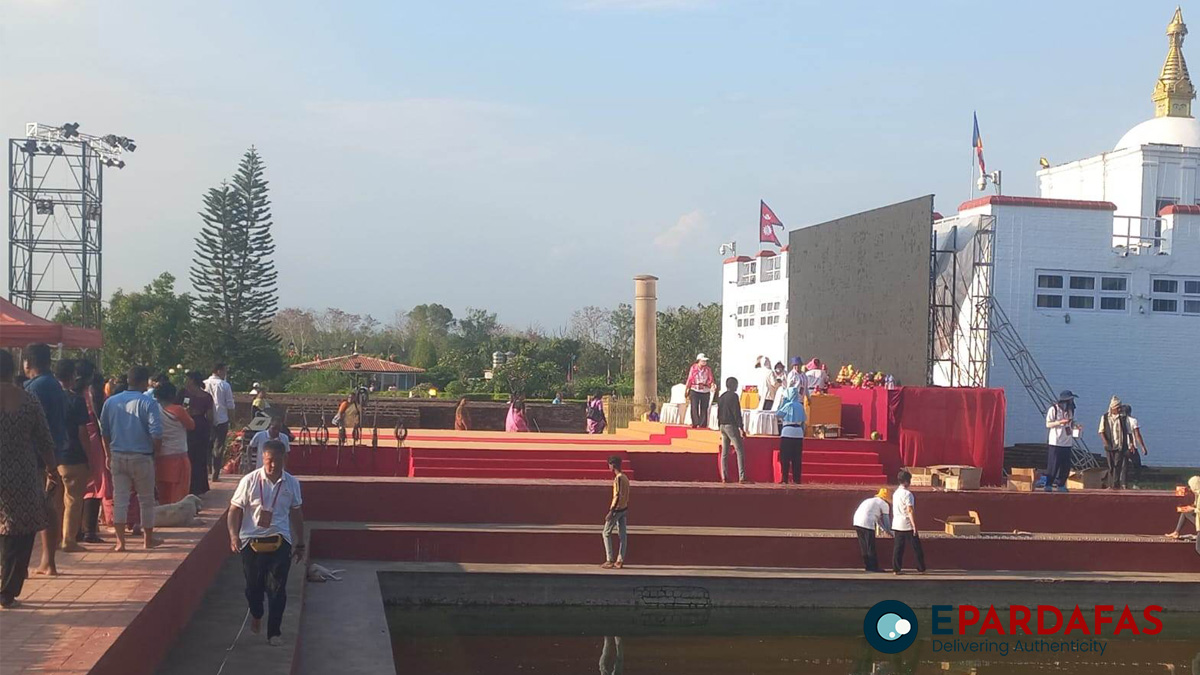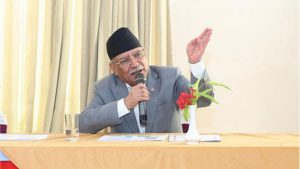
Chinese Monastery Occupies Entire Maya Devi Temple Complex Ahead of Buddha Purnima
After obtaining permission from the Lumbini Development Trust to light a lamp, the Chinese monastery situated in the Lumbini area has occupied the entire Maya Devi Temple complex.
On Thursday, the Chinese monastery was authorized to light the lamp for a limited duration, following which they installed a platform and a board in such a way that the entire Mayadevi temple is now obstructed from view. Moreover, several hundred Chinese individuals have started moving around the temple premises.

Sanuraja Shakya, the Member Secretary of the Trust said to epardafas that the monastery had sought permission to conduct a lamp lighting program and had erected the stage for only a few hours. In a statement to epardafas, he clarified that the stage was not intended to overshadow the entire Mayadevi temple and that the permission granted was only for the program and not for the construction of a large stage. He stated, “Permission has been taken from us to hold a program, not to build a stage. There was no such thing as making it so big. Only for two hours.”

The location housing the Mayadevi Temple and the Ashoka Pillar within the Lumbini complex is recognized as a UNESCO World Heritage Site. In order to ensure safety and protection of the area, the trust managing the site has banned shoes and slippers, even at the entrance. However, contrary to these regulations, a program of this nature is currently taking place in the area.

According to a former executive member of the fund, the current composition of the fund is biased towards individuals with ties to China. He expressed his surprise at the approval of a program that would generate significant noise pollution in the peace zone and heritage area.
On Friday, Prime Minister Pushpa Kamal Dahal ‘Prachanda’ and Chinese Ambassador to Nepal Chen Song are slated to participate in a special program commemorating Buddha Jayanti. However, sources report that the Chinese embassy disregarded the UNESCO-listed heritage and organized the program to assert its influence.
This is evident as some Chinese political leaders are attending a program in Lumbini, the birthplace of Buddha and a UNESCO-protected World Heritage SIte, on Friday.
Observers raise concerns as to how can political leaders of a Communist state, who do not believe in religion, attend a religious program and that too in a World Heritage Site on the occasion of Buddha Jayanti.
It may be noted that Han Song, General Secretary of a Chinese religious and cultural organization arrived in Kathmandu Wednesday night to participate in the program leading an 11-member team.
Song arrived at Kathmandu airport at 10:30 pm on Cathay Pacific Air flight number CX 603.
The organizer has invited Prime Minister Pushpa Kamal Dahal “Prachanda”, Minister of Culture, Tourism and Civil Aviation, Sudan Kirati, Ambassador of China to Nepal and others.
China, as observers note, is endeavoring to carve out its strategic influence using Buddhism as a tool to expand its footprints in Nepal as well as antagonizing Nepali Buddhists by organizing a political program near the Maya Devi Temple in Lumbini that has a strict guideline.
It can be said that the program is an enhanced effort to get Tibetan Buddhism to adapt to “socialism” that has Chinese characteristics besides provoking Nepali and Indians at a time when both India and Nepal are jointly working toward promoting Lumbini and Buddhism worldwide.
This, as observers note, is contrary to Beijing’s claim of religious freedom in Tibet.
It may be noted that the Government of India announced Buddhist Circuit in 2016 that follows in the footsteps of Buddha from Lumbini through India’s Bihar to Sarnath and Kushinagar in Uttar Pradesh.
As Dalai Lama said earlier this year “China is systematically trying to destroy Buddhism but can’t crush people’s faith in the Buddha” referring to Beijing’s demolition of the statue of Padmasambhava in early March, the third such destruction since December 2021 and the second in Tibet’s Drago County since January 2022.
To refer to Lama’s statement, he said, “Our people were poisoned. China did everything possible to harm Buddhism.”
Some say that Beijing has also deployed numerous methods to eradicate Buddhism not only within Tibet and elsewhere.
To recall, several Tibetan monasteries have been demolished in the past.
And this seems true as it is holding a political program in the name of Buddhism in Nepal’s holy site, Lumbini.
China has been using Buddhist diplomacy in Nepal to consolidate an advantage here.
According to observers, China is playing a long game, and is trying to move fast to “alarm the Nepalis” as a large Nepali populace feels surrounded by Chinese influence.
In fact, China has been trying to appropriate Buddhism to secure its economic and cultural advantage in Nepal aimed at weakening India’s relations with Nepal.















Comments